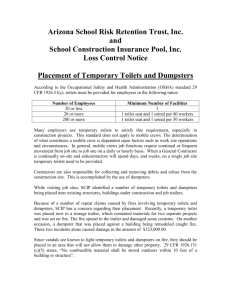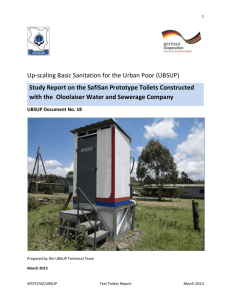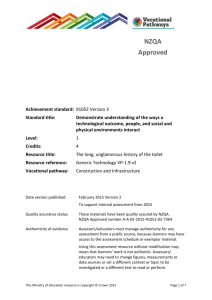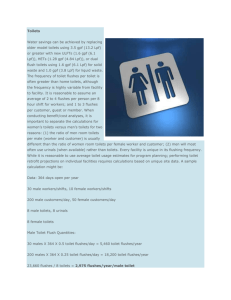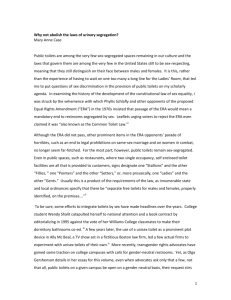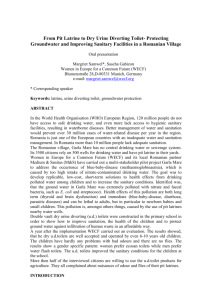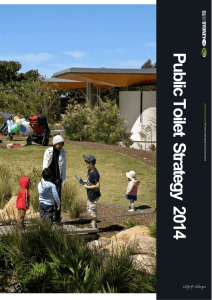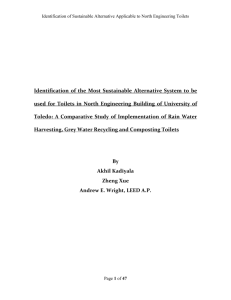Energy and Water Audit (docx 450.2 KB)
advertisement
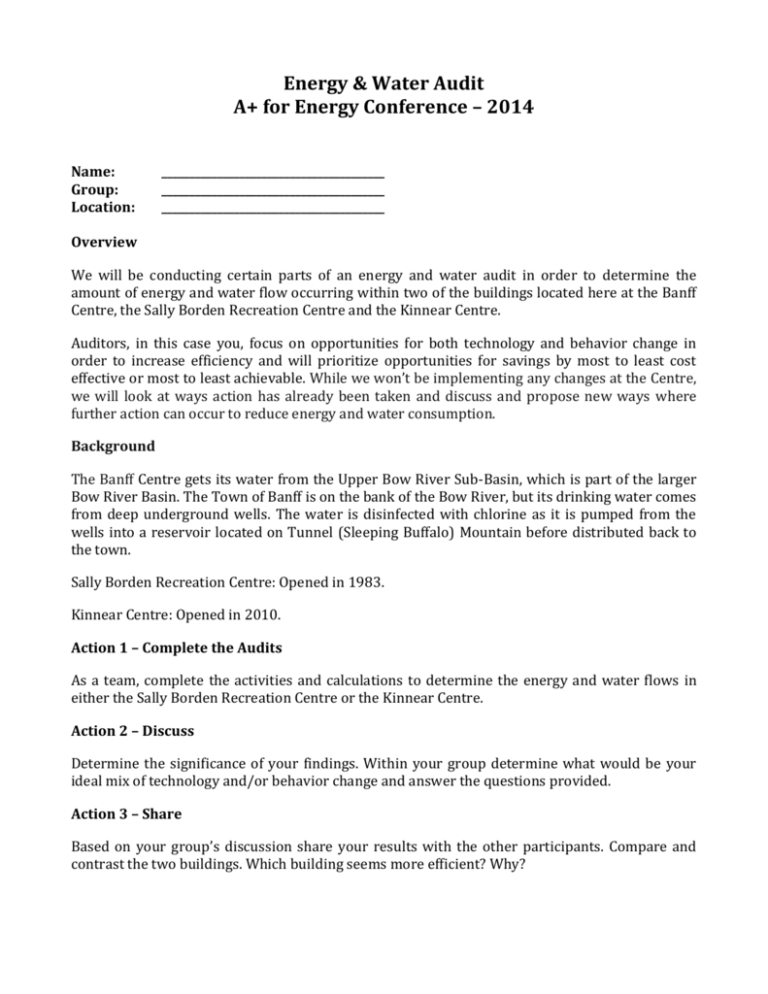
Energy & Water Audit A+ for Energy Conference – 2014 Name: Group: Location: ________________________________________ ________________________________________ ________________________________________ Overview We will be conducting certain parts of an energy and water audit in order to determine the amount of energy and water flow occurring within two of the buildings located here at the Banff Centre, the Sally Borden Recreation Centre and the Kinnear Centre. Auditors, in this case you, focus on opportunities for both technology and behavior change in order to increase efficiency and will prioritize opportunities for savings by most to least cost effective or most to least achievable. While we won’t be implementing any changes at the Centre, we will look at ways action has already been taken and discuss and propose new ways where further action can occur to reduce energy and water consumption. Background The Banff Centre gets its water from the Upper Bow River Sub-Basin, which is part of the larger Bow River Basin. The Town of Banff is on the bank of the Bow River, but its drinking water comes from deep underground wells. The water is disinfected with chlorine as it is pumped from the wells into a reservoir located on Tunnel (Sleeping Buffalo) Mountain before distributed back to the town. Sally Borden Recreation Centre: Opened in 1983. Kinnear Centre: Opened in 2010. Action 1 – Complete the Audits As a team, complete the activities and calculations to determine the energy and water flows in either the Sally Borden Recreation Centre or the Kinnear Centre. Action 2 – Discuss Determine the significance of your findings. Within your group determine what would be your ideal mix of technology and/or behavior change and answer the questions provided. Action 3 – Share Based on your group’s discussion share your results with the other participants. Compare and contrast the two buildings. Which building seems more efficient? Why? Water Audit Materials required: Flow rate bag Dye tablets Container with liters and gallons marked Masking Tape Timer (watch or cell phone timer) Toilets 1. Conventional toilets generally use about 13 L of water per flush while low flow toilets use less than half that, about 6 L. Are low flow toilets installed? Yes No 2. Can you shut off the water supply valve? If not, is the flow rate labeled on the toilet? Skip to Question 3. If yes, calculate the volume of water used during each flush. Use the following instructions and materials provided to complete your calculations. Note: The instructions below indicate measurements in gallons. For our purposes, we will use liters. 2 Number of jugs required to fill the tank Number of jugs required to fill the bowl + __________ __________ = __________ (L/flush) 3. How many people do you think use the bathroom a day? Home use is pretty easy to predict, but for larger facilities like gymnasiums, health centres, or public washrooms, use can be difficult to measure. When considering your own school facilities, it is important to separate women’s toilets versus men’s toilets for two reasons: (1) the ratio of men room toilets per male is usually different than the ratio of women toilets per female, and (2), men will most often use urinals (when available) rather than toilets. For public washrooms, assume 25 guests per day use each toilet once. How much water is flushed away every day? __________ (L/flush) x __________ (# of toilets in the building) = __________ (average L/day flushed) How much water is flushed every year? x __________ (# of flushes/day) 3 x __________ (average L/day flushed) 365 (days/year) = __________ (average L/year flushed) 4. Use the provided Leak Detecting Dye Tablet to determine if the toilet has a leak. Step 1: Put the dye tablet into the toilet tank Step 2: After at least 5 minutes, check the toilet bowl Step 3: If the water in the bowl has changed color, there is a leak! Does the toilet leak? Yes No Sinks 5. Tap aerators (the mesh covering across the tip of the faucet) reduce the total flow of water by breaking it up as it leaves the faucet. Are tap aerators installed on the faucets in the bathroom sinks? Yes No 6. Flow rate is measured as volume per minute. What is the flow rate of the sink? Measure using flow rate bags provided. Instructions are on the bag. Sink flow rate: __________ L/minute For public washrooms, assume 25 guests use the sink for 0.5 minutes each. How much water is used in the sinks each day? __________ (L/minute) x 0.5 (minutes/use) x __________ (# sinks in the building) = __________ (average L/day) How much water is used per year? x __________ (# uses/day) 4 x __________ (average L/day) 365 (days/year) = __________ (average L/year) Building Totals 9. Considering both appliances, what is the total amount of water used in this building? Each day? __________ average L/day (toilet) + __________ average L/day (sink) = __________ (L/day/building) Each year? __________ (L/day/room) x 365 (days/year) = __________ L/year/building 5 Energy Audit Consider the following question when conducting your audit. Use them to guide your study. Consider why the questions have been asked. Draw on your own knowledge and experience to explore other factors that may be important to study. Conference Rooms What type of lighting is used? Does each room have an adjustable thermostat? Check baseboard-type radiators. Are Openings or metal fins inside blocked or filled with dust? Is there a draft coming from the windows? Under the doors? Where is the phantom energy being used? Other: Yes/No Comments Washrooms/Change Rooms Are the faucets free from drips? Have aerators been placed over the ends of taps? Are low flush toilets installed in the washrooms/change rooms? Other: Yes/No Comments Computer Lab What type of lighting is used? Are the lights left on at all times, or only when the room is in use? Are the computers left on when not in use? Are the computers plugged into the power bars, or directly into the wall? Where is the phantom energy being used? Other: Yes/No Comments Building Wide Have education campaigns been used to inform people on how to be energy efficient? Other: Yes/No Comments Interior Yes/No Are the ceilings insulated? How think is the insulation? Is there a vapor barrier on the indoor side of the insulation? About how much of the floor is covered with rugs, padding, and carpeting? (Estimate a percentage). Is the heating and cooling equipment (ducts, grilles, radiators) blocked by furniture, rugs, or drapes? Are walls and ceilings light enough in color to reflect light well? Have drafts been detected along edges of doors and windows? Make a list of possible drafty openings. Examples: plumbing pipes entering walls, exhaust fans in kitchen or bathroom while turned off, chimney pipes exiting through walls or ceilings. What type of water heating system is used? Is there one central water heater or are individual heaters used throughout the school? Is the hot water heater turned on all day? Turned off at night? Check the basement for exposed hot water or steam pipes. Are they all insulated? Has the furnace been cleaned and serviced in the last year with the filter cleaned or replaced? Is there a central cooling system? When is this used? What type of lighting is used throughout the building? Are motion sensors used with lighting in certain parts of the building? Have education campaigns been used with the staff on how to be energy efficient? Other: Comments Other: Other: 7 Exterior What type of windows are used? Are there storm windows in place? Are there fewer windows on the north side of the school than on the south side? Are the north windows smaller than those on the other sides? Is there an air lock entry hall, double door, or insulated storm door at each outside entrance? Is there weather-stripping around the inner and outer doors? Around the windows? Are cracks and joints around windows, doors, stairways, pipes, and electrical wires caulked? Does the roof on the south side extend further out to shade walls and windows in the summer? Will the roof overhang allow the lower winter sun to warm south walls and windows? When was he roof last replaced? Are coniferous shrubs and tree planted as windbreaks around the north and west sides of the building? Are deciduous trees planted on the south side for summer shade and winter sun? Are the gardens planted with native plants? Do they require watering? Are exterior lights run on a timer? Do the hours they are run change with the season? Other: Yes/No Comments Other: Other: 8 Discussion As a group discuss your findings. How are your results significant? Did anything surprise you? What areas have we not considered and how will these areas affect the overall energy and/or water flows at the Centre? Complete research or use the existing knowledge of your team to determine what would be your ideal mix of technology and behavior change. Following your discussion, complete the sections below and be prepared to share during the group discussion. *Please provide answers for both energy and water. 1. Following our research, we have observed the following areas of success in energy and water efficiency (please include why you have identified these areas): 2. Following our research, we have identified the following opportunities to increase energy and water efficiency (prioritize your answers by most to least cost effective or most to least achievable): 3. In our schools, we could use this activity and the information we collected in the following ways: 9
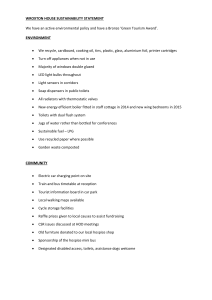
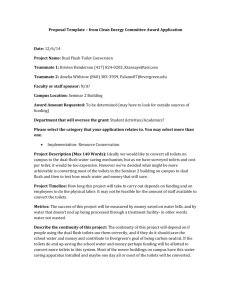
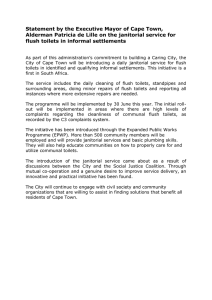
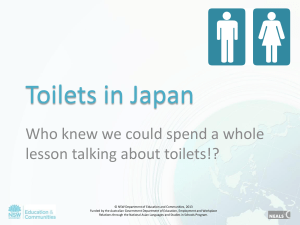

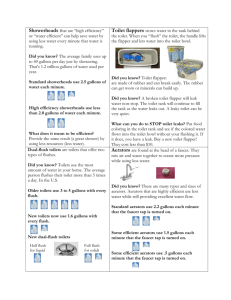

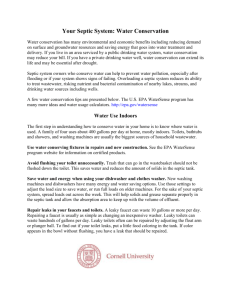
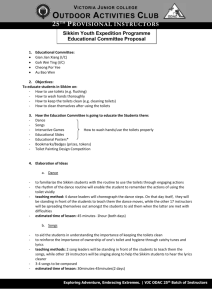

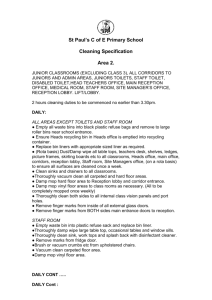
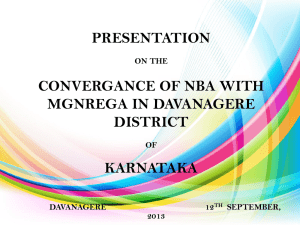
![High Efficiency Toilets [HETs] S](http://s2.studylib.net/store/data/012093820_1-aed381b27635745affa02e3c7ede33fb-300x300.png)
